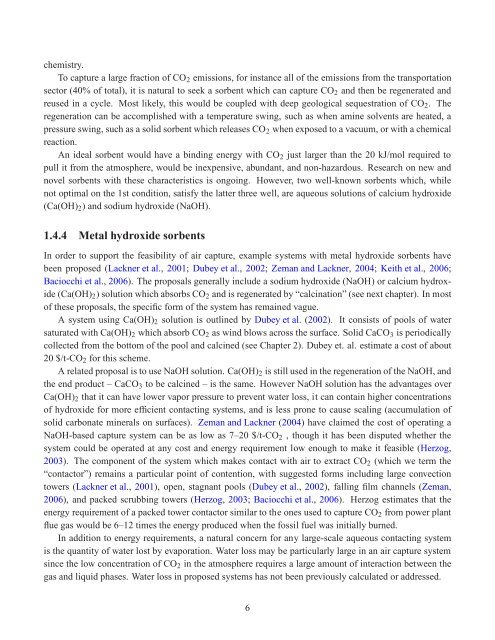Capturing CO2 from ambient air - David Keith
Capturing CO2 from ambient air - David Keith
Capturing CO2 from ambient air - David Keith
You also want an ePaper? Increase the reach of your titles
YUMPU automatically turns print PDFs into web optimized ePapers that Google loves.
chemistry.<br />
To capture a large fraction of <strong>CO2</strong> emissions, for instance all of the emissions <strong>from</strong> the transportation<br />
sector (40% of total), it is natural to seek a sorbent which can capture <strong>CO2</strong> and then be regenerated and<br />
reused in a cycle. Most likely, this would be coupled with deep geological sequestration of <strong>CO2</strong>. The<br />
regeneration can be accomplished with a temperature swing, such as when amine solvents are heated, a<br />
pressure swing, such as a solid sorbent which releases <strong>CO2</strong> when exposed to a vacuum, or with a chemical<br />
reaction.<br />
An ideal sorbent would have a binding energy with <strong>CO2</strong> just larger than the 20 kJ/mol required to<br />
pull it <strong>from</strong> the atmosphere, would be inexpensive, abundant, and non-hazardous. Research on new and<br />
novel sorbents with these characteristics is ongoing. However, two well-known sorbents which, while<br />
not optimal on the 1st condition, satisfy the latter three well, are aqueous solutions of calcium hydroxide<br />
(Ca(OH)2) and sodium hydroxide (NaOH).<br />
1.4.4 Metal hydroxide sorbents<br />
In order to support the feasibility of <strong>air</strong> capture, example systems with metal hydroxide sorbents have<br />
been proposed (Lackner et al., 2001; Dubey et al., 2002; Zeman and Lackner, 2004; <strong>Keith</strong> et al., 2006;<br />
Baciocchi et al., 2006). The proposals generally include a sodium hydroxide (NaOH) or calcium hydroxide<br />
(Ca(OH)2) solution which absorbs <strong>CO2</strong> and is regenerated by “calcination” (see next chapter). In most<br />
of these proposals, the specific form of the system has remained vague.<br />
A system using Ca(OH)2 solution is outlined by Dubey et al. (2002). It consists of pools of water<br />
saturated with Ca(OH)2 which absorb <strong>CO2</strong> as wind blows across the surface. Solid CaCO3 is periodically<br />
collected <strong>from</strong> the bottom of the pool and calcined (see Chapter 2). Dubey et. al. estimate a cost of about<br />
20 $/t-<strong>CO2</strong> for this scheme.<br />
A related proposal is to use NaOH solution. Ca(OH)2 is still used in the regeneration of the NaOH, and<br />
the end product – CaCO3 to be calcined – is the same. However NaOH solution has the advantages over<br />
Ca(OH)2 that it can have lower vapor pressure to prevent water loss, it can contain higher concentrations<br />
of hydroxide for more efficient contacting systems, and is less prone to cause scaling (accumulation of<br />
solid carbonate minerals on surfaces). Zeman and Lackner (2004) have claimed the cost of operating a<br />
NaOH-based capture system can be as low as 7–20 $/t-<strong>CO2</strong> , though it has been disputed whether the<br />
system could be operated at any cost and energy requirement low enough to make it feasible (Herzog,<br />
2003). The component of the system which makes contact with <strong>air</strong> to extract <strong>CO2</strong> (which we term the<br />
“contactor”) remains a particular point of contention, with suggested forms including large convection<br />
towers (Lackner et al., 2001), open, stagnant pools (Dubey et al., 2002), falling film channels (Zeman,<br />
2006), and packed scrubbing towers (Herzog, 2003; Baciocchi et al., 2006). Herzog estimates that the<br />
energy requirement of a packed tower contactor similar to the ones used to capture <strong>CO2</strong> <strong>from</strong> power plant<br />
flue gas would be 6–12 times the energy produced when the fossil fuel was initially burned.<br />
In addition to energy requirements, a natural concern for any large-scale aqueous contacting system<br />
is the quantity of water lost by evaporation. Water loss may be particularly large in an <strong>air</strong> capture system<br />
since the low concentration of <strong>CO2</strong> in the atmosphere requires a large amount of interaction between the<br />
gas and liquid phases. Water loss in proposed systems has not been previously calculated or addressed.<br />
6








